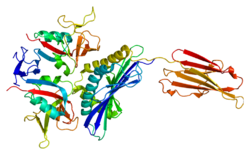NKG2D is an activating receptor (transmembrane protein) belonging to the NKG2 family of C-type lectin-like receptors.[5] NKG2D is encoded by KLRK1 (killer cell lectin like receptor K1) gene which is located in the NK-gene complex (NKC) situated on chromosome 6 in mice[6] and chromosome 12 in humans.[7] In mice, it is expressed by NK cells, NK1.1+ T cells, γδ T cells, activated CD8+ αβ T cells and activated macrophages.[8] In humans, it is expressed by NK cells, γδ T cells and CD8+ αβ T cells.[9] NKG2D recognizes induced-self proteins from MIC and RAET1/ULBP families which appear on the surface of stressed, malignant transformed, and infected cells.[10]
- ^ a b c GRCh38: Ensembl release 89: ENSG00000213809 – Ensembl, May 2017
- ^ a b c GRCm38: Ensembl release 89: ENSMUSG00000030149 – Ensembl, May 2017
- ^ "Human PubMed Reference:". National Center for Biotechnology Information, U.S. National Library of Medicine.
- ^ "Mouse PubMed Reference:". National Center for Biotechnology Information, U.S. National Library of Medicine.
- ^ Houchins JP, Yabe T, McSherry C, Bach FH (April 1991). "DNA sequence analysis of NKG2, a family of related cDNA clones encoding type II integral membrane proteins on human natural killer cells". The Journal of Experimental Medicine. 173 (4): 1017–20. doi:10.1084/jem.173.4.1017. PMC 2190798. PMID 2007850.
- ^ Brown MG, Fulmek S, Matsumoto K, Cho R, Lyons PA, Levy ER, et al. (May 1997). "A 2-Mb YAC contig and physical map of the natural killer gene complex on mouse chromosome 6". Genomics. 42 (1): 16–25. doi:10.1006/geno.1997.4721. PMID 9177771.
- ^ Yabe T, McSherry C, Bach FH, Fisch P, Schall RP, Sondel PM, Houchins JP (1993). "A multigene family on human chromosome 12 encodes natural killer-cell lectins". Immunogenetics. 37 (6): 455–60. doi:10.1007/BF00222470. PMID 8436421. S2CID 27350036.
- ^ Jamieson AM, Diefenbach A, McMahon CW, Xiong N, Carlyle JR, Raulet DH (July 2002). "The role of the NKG2D immunoreceptor in immune cell activation and natural killing". Immunity. 17 (1): 19–29. doi:10.1016/S1074-7613(02)00333-3. PMID 12150888.
- ^ Bauer S, Groh V, Wu J, Steinle A, Phillips JH, Lanier LL, Spies T (July 1999). "Activation of NK cells and T cells by NKG2D, a receptor for stress-inducible MICA". Science. 285 (5428): 727–9. doi:10.1126/science.285.5428.727. PMID 10426993.
- ^ Raulet DH (October 2003). "Roles of the NKG2D immunoreceptor and its ligands". Nature Reviews. Immunology. 3 (10): 781–90. doi:10.1038/nri1199. PMID 14523385. S2CID 18234848.




